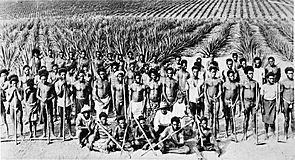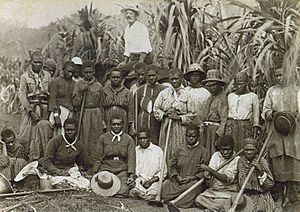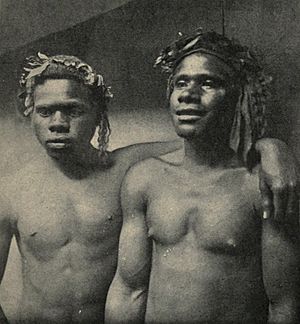Kanaka (Pacific Island worker) facts for kids
Kanakas were workers from different Pacific Islands. They were employed in British colonies during the 1800s and early 1900s. These colonies included places like British Columbia (Canada), Fiji, Solomon Islands, Vanuatu, Papua New Guinea, and Queensland (Australia). Some also worked in California and Chile.
The word "Kanaka" first meant only native Hawaiians. It came from their own language, kānaka ʻōiwi or kānaka maoli. In the Americas, most Kanakas were Hawaiians. But in Australia, most were from Melanesia. Today, in Australian English, "kanaka" is usually avoided. This is because it has been used as an offensive term.
Kanaka Workers in Australia

In Australia, the word "kanaka" is now seen as offensive for a Pacific Islander. Most "Kanakas" in Australia came from Melanesia, not Polynesia. Their descendants today often call themselves "South Sea Islanders." This is also the official term used by the government.
Most of these workers were recruited or tricked into working. Some were even kidnapped from places like the Solomon Islands and New Hebrides (now Vanuatu). In Queensland, workers usually signed up for three years. After that, they were given a free trip home. They often saved money to buy goods before leaving.
The first group of 65 Melanesian workers arrived in Boyd Town in 1847. They came on a ship called the Velocity. A Scottish colonist named Benjamin Boyd wanted cheap workers for his large farms. He brought more Islanders, but many ran away. They were found starving in Sydney. After some problems, using Melanesian workers stopped for a while.
The practice started again in the 1860s. After 1863, over 62,000 Islanders were brought to Australia. By 1901, about 10,000 lived in Queensland and northern New South Wales. Most were sent back home between 1906 and 1908. This was due to a law called the Pacific Island Labourers Act 1901. This law supported the White Australia policy, which aimed to keep Australia mostly white. Some Islanders were allowed to stay, especially if they were married to Australians.
The descendants of those who stayed are now Australia's largest Melano-Polynesian group. Many Australian South Sea Islanders have mixed backgrounds. They are sometimes mistaken for Aboriginal and Torres Strait Islanders. Because of this, they have faced similar unfair treatment. In 1994, the Australian South Sea Islander community was recognized. A report found they faced more disadvantages than Indigenous Australians.
Kanaka Workers in Canada
In Canada, Kanakas were all from Hawaii. They arrived on early exploration and trading ships. Some Kanakas left their ships and lived with First Nations people. The first Kanakas to settle helped build Fort Langley in 1827.
They often worked for fur trading companies. Many were hired by the Hudson's Bay Company. Others came as sailors or moved north from California. The Kanaka Rancherie was a Hawaiian worker settlement in Vancouver.
Many Kanaka men married First Nations women. Their descendants live in British Columbia and parts of the United States. Kanaka Creek, British Columbia, was a community of mixed Hawaiian-First Nations families. It was set up in the 1830s near Fort Langley.
Kanakas also worked in the California Gold Rush and the Fraser Canyon Gold Rush. Kanaka Bar, British Columbia is named after gold claims worked by Kanakas. Today, it is a First Nations community. In British Columbia and California, the term "Kanaka" was not negative. It still means someone of Hawaiian background without being offensive.
Some experts believe the nickname "Canuck" for Canadians comes from the Hawaiian word "Kanaka."
Kanaka Workers in the United States
The first Hawaiian workers arrived in the United States in 1811. They came on a ship called the Tonquin. They helped build Fort Astoria in Oregon. About a third of the workers there were Kanakas. Kanakas also helped build Russian Fort Elizabeth in Hawaii in 1817.
By the 1820s, Kanakas worked in skilled jobs at Fort Vancouver. They lived in an area called "Kanaka Village." Kanakas also worked in farming and ranching in California as early as 1834. They worked under Spanish rule and later for American companies. A writer named Richard Henry Dana Jr. wrote about Kanaka workers in California in his book Two Years Before the Mast.
More Kanakas moved to the US between 1900 and 1930. Many of their families married into Chinese, Filipino, and Mexican communities. At one time, Native Hawaiians harvested sugar beets and picked apples. This happened in the states of Washington and Oregon.
Kanakas left their mark on place names in Oregon. Examples include Kanaka Flat in Jacksonville. The Owyhee River is another example. "Owyhee" is an old spelling of Hawaii. There is also the Kanaka Gulch.




